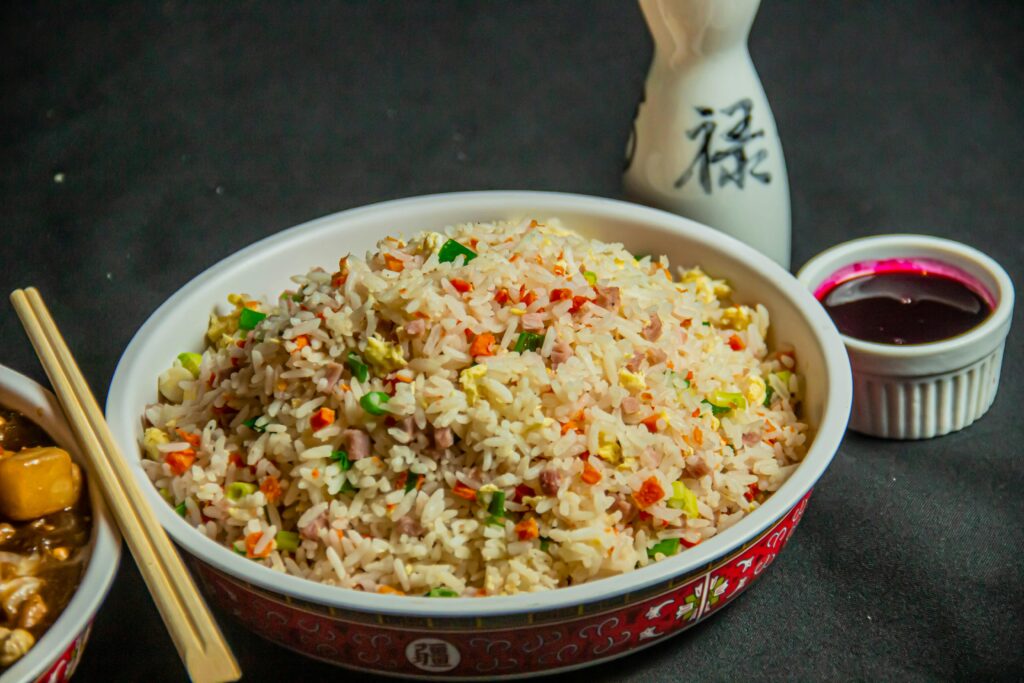Have you ever tasted fried rice that feels like a warm hug rather than just a quick meal? That’s what Fu Jian Fried Rice brings to the table. It’s not your regular wok-tossed rice; it’s rice dressed in a silky, savory sauce that seeps into every grain. Each bite feels like comfort with elegance, and every mouthful tells a story of southern China’s rich culinary heritage. If you’ve ever wanted to know what makes this dish so unique and how it captures hearts across Asia, you’re about to find out.

What Is Fujian (Fujian) Fried Rice?
Fu Jian Fried Rice, or Fujian Fried Rice, stands out for its glossy gravy instead of a dry finish. The fluffy rice sits beneath a rich, savory sauce that adds depth and elegance. Unlike regular fried rice that relies on soy and oil, this dish shines through its flavorful sauce and balance of fresh ingredients.
Order Online
Fujian cuisine in one bite
Fujian cuisine, or Hokkien cuisine as it’s sometimes called, originates from China’s southeastern coast. The region is known for its balanced flavors, fresh seafood, and broths that celebrate subtlety rather than heaviness. When you take a bite of Fujian Fried Rice, you’re experiencing Fujian’s entire culinary philosophy in one mouthful — delicate, savory, aromatic, and slightly sweet. It’s a beautiful mix of textures, from tender shrimp and crisp vegetables to soft rice drenched in umami-rich sauce.
Origins and History — Where Did It Come From?
Fu Jian Fried Rice originated in Fujian’s coastal cities, shaped by trade and rich seafood culture. Cooks combined leftover rice with fresh seafood and thick sauce for a quick, comforting meal. The dish later spread across Southeast Asia, especially Malaysia and Singapore, where it evolved but kept its signature saucy style.
From port cities to street stalls
Fu Jian Fried Rice’s journey from high-end port dining rooms to bustling street stalls is fascinating. Fujianese traders and sailors carried their recipes overseas, adapting them with local flavors wherever they went. That’s why you can find versions of this dish in many Asian countries, each slightly different but unmistakably Fujian at heart. From coastal restaurants to night markets, its saucy charm never fails to attract both locals and travelers.
Key Ingredients You’ll Need
Fu Jian Fried Rice gets its flavor from simple yet key ingredients. Day-old rice stays firm and non-sticky, while shrimp, chicken, or pork add richness. Peas, mushrooms, and carrots bring color and crunch. Garlic, scallions, and a savory stock create depth, and soy sauce, oyster sauce, sesame oil, and cornstarch tie it all into a glossy, flavorful dish.
The magic of the gravy
The secret behind this dish lies in its iconic gravy. It’s not meant to drench the rice completely but rather to rest on top, allowing the flavors to seep in gradually. The sauce, usually made from stock enhanced with oyster sauce and soy, thickens into a glossy finish that glistens on the plate. Unlike dry fried rice, this version feels almost luxurious, giving you the best of both worlds — soft, saucy, and aromatic. Once you try it, even simple fried rice will never taste quite the same again.
Pantry staples and optional add-ins
Having the right staples can make preparation much easier. Keeping cooked rice, frozen peas, a bottle of oyster sauce, and cornstarch in your kitchen means you’re halfway there. If you prefer a touch of spice, a dash of chili oil works beautifully. For vegetarian adaptations, mushroom stock and tofu replace the seafood effortlessly. The recipe’s flexibility makes it perfect for any kitchen setup or dietary preference while still maintaining its authentic Fujian spirit.
Equipment and Prep Tips
A wok works best for Fu Jian Fried Rice because it heats evenly, though a sturdy pan also does the job. Prep everything before cooking since the process moves fast. Use chilled, day-old rice for the best texture, or cool fresh rice on a tray to dry it out. Keep your cornstarch slurry ready so the gravy thickens perfectly when added.
Step-by-Step Recipe (Cook-along)
Cooking Fu Jian Fried Rice is a quick and exciting process that feels almost theatrical once the sauce meets the hot rice. The key is to maintain high heat and constant movement so nothing burns and every flavor shines through.
Method: Make the sauce first
Start by heating a small saucepan and pouring in the stock. Add soy sauce, oyster sauce, and sugar, then bring it to a gentle simmer. Mix your cornstarch slurry and pour it in slowly, stirring continuously until the sauce becomes thick and glossy. Once it reaches that beautiful sheen, remove it from the heat but keep it warm. Making the sauce first gives you a head start and ensures the final pour happens right on time.
Frying the rice properly
Sauté garlic and scallion whites, then scramble in the eggs. Toss in rice to absorb the flavors, add soy sauce and sesame oil, then mix in vegetables and proteins until heated through. Serve with warm gravy poured on top for a glossy, savory finish.
Common Mistakes — And How to Fix Them
Even simple dishes can fail if not handled carefully. Mushy rice usually means it wasn’t dry enough—day-old rice works best. If the gravy is too thin, add cornstarch slowly over low heat. Adjust flavor with a pinch of sugar or extra soy sauce to maintain balance.
Variations and Serving Ideas
Fu Jian Fried Rice is adaptable and can be transformed to fit different moods. You can create a seafood version filled with shrimp, squid, and scallops, turning it into a coastal feast. For those who enjoy spice, a few spoonfuls of chili paste will add a bold kick. Vegetarians can use tofu, mushrooms, and vegetable stock for a lighter yet equally satisfying meal.
In some regions, cooks even add dark soy sauce and caramelized shallots for a deeper, smoky undertone. Each version pays homage to the original while reflecting local tastes and creativity.
Restaurant vs home-style
Restaurant versions often boast intense flavors because of the high heat from professional gas stoves and the use of concentrated stock. At home, you can achieve a similar result by preheating your wok well, using high-quality ingredients, and ensuring that your sauce is rich enough to carry the flavors. Keep your ingredients ready so nothing overcooks. Letting the sauce rest for a few minutes before pouring it over the rice can also help it thicken slightly and develop more depth.
Nutrition and Health Notes
Fu Jian Fried Rice is rich yet can be balanced. It offers protein, carbs, and fiber. Using brown rice, less oil, and more vegetables makes it lighter, and low-sodium sauces or natural seasonings keep it healthy without losing flavor.
Pairings: What to Serve with Fu Jian Fried Rice
Fu Jian Fried Rice pairs wonderfully with light and refreshing sides. A simple soup made from chicken broth or egg drop balances the richness of the sauce. A cucumber salad or pickled vegetables adds crunch and acidity, cutting through the savory notes. For drinks, tea or a crisp, cold lager works beautifully, cleansing your palate between each bite. The harmony between the saucy rice and a refreshing side dish enhances the overall dining experience.
Why Fu Jian Fried Rice Works — Flavor Science
This dish succeeds because it layers flavors and textures with precision. The base of the sauce delivers umami from stock and oyster sauce, the proteins bring natural sweetness, and the sesame oil gives a nutty aroma. The contrast between fluffy rice and creamy sauce is addictive. Scientifically, this balance appeals to multiple taste receptors — sweet, salty, and umami — all at once. It’s like an orchestra where each instrument plays in perfect sync, creating a dish that lingers in memory long after the last bite.
Quick Tips to Impress
A few small tricks can elevate your Fu Jian Fried Rice to restaurant quality. Adding a splash of rice wine to the gravy lifts its flavor instantly. Finishing with a drizzle of sesame oil at the very end enhances aroma without overpowering the taste. Serving the sauce while it’s piping hot allows it to sizzle slightly when it hits the rice, making the dish more aromatic and exciting. Even a simple garnish of thinly sliced scallions gives it a professional finish that will impress any guest.
Conclusion to Fu Jian Fried Rice
Fu Jian Fried Rice isn’t just another fried rice recipe; it’s an experience — a comforting plate of food that captures the warmth of home and the sophistication of restaurant dining. It’s where soft meets crisp, where subtle meets savory, and where simplicity turns into art. Whether you’re making it for a family dinner or to relive a memory from your favorite Chinese restaurant, it delivers pure joy. So go ahead, heat that wok, make your gravy shine, and serve up a taste of southern China right in your kitchen.
FAQs about Fujian Fried Rice Food
Q1 — What makes Fu Jian Fried Rice Food different from regular fried rice?
Fu Jian Fried Rice Food stands out because of its rich, savory gravy poured over the fried rice. Unlike dry fried rice, it combines fluffy grains with a glossy, flavorful sauce that brings every ingredient together.
Q2 — Is Fu Jian Fried Rice Food spicy or mild in flavor?
Fujian Fried Rice Food is generally mild and balanced. It’s more savory and aromatic than spicy. However, you can easily adjust the heat by adding chili oil or fresh chili to the sauce.
Q3 — Can I make Fu Jian Fried Rice Food with leftover rice?
Yes, leftover rice perfect for Fu Jian Fried Rice Food. Day-old rice has less moisture, allowing the grains to stay separate and absorb the gravy better without turning mushy.
Q4 — What are the main ingredients used in Fu Jian Fried Rice Food?
The signature ingredients of Fu Jian Fried Rice Food include cooked rice, shrimp or chicken, mixed vegetables, soy sauce, oyster sauce, garlic, scallions, and a thick, flavorful stock-based gravy.
Q5 — Is Fu Jian Fried Rice Food healthy to eat regularly?
Fried Rice Food can be healthy when prepared with less oil, more vegetables, and lean protein. Using brown rice and low-sodium sauces makes it lighter without losing its authentic flavor.
